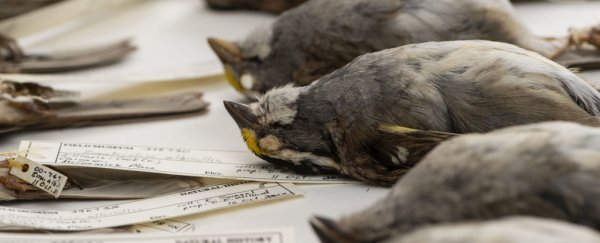Getting around in a city can be a lot more dangerous than wide open spaces, and that, it seems, is true for migratory birds as well, especially if they're in the habit of calling out to each other at night.
A new study has analysed the deaths of 70,000 songbirds that died after colliding with buildings in Cleveland and Chicago at night. The researchers' analysis spans a 40-year period, and found that species who communicate with each other using flight calls are most at risk.
It is, the researchers think, directly linked to how we light our cities.
"Nocturnal flight calls likely evolved to facilitate collective decision-making among birds during navigation," said evolutionary biologist Benjamin Winger of the University of Michigan, "but this same social behaviour may now exacerbate vulnerability to a widespread anthropogenic disturbance: artificial light from buildings."
Many bird species migrate at night, travelling long distances in the dark, using flight calls to communicate - to help navigate and orient themselves, to keep the flock together, and make group decisions.
Previous research has shown that artificial light is linked with an increase in flight calls in nocturnally migrating birds. Over cities, the birds call out to each other three times more often than over darker rural areas.
The Field Museum in Chicago has been collecting avian collision data since 1978, and this is what the researchers used to conduct their investigation. They also used more recent data collected by volunteers in both cities.
Cleveland and Chicago are of special interest, since they are both along a north-south migratory bird flyway. As well as more general analysis of city-wide collisions, the team paid particular attention to Chicago's lakefront convention centre, a known hazard to migratory birds.
They found that when the convention centre left its lights off, fewer birds collided.
They also found that, of the 93 species in the data, several species of flight-calling sparrow, warbler, and thrush make up the majority of the fatal collisions, accounting for several thousand deaths.
When they compared collision data to population data, these "super collider" birds were vastly over-represented. But birds that don't make nocturnal flight calls were under-represented.
"We hypothesised that if flight calls are important social cues for decision-making during nocturnal migration, individuals from species that make flight calls may attract one another vocally when disoriented by artificial light," the researchers wrote in their paper.
"This relationship may spawn a vicious cycle of increased mortality rates if disoriented individuals lead other migrating individuals to sources of artificial light."
Of course, it is difficult to say for sure without directly observing the relationship between nocturnal flight calls and building collisions - but it does point to a direction in which the research can be taken.
And it's pretty strong evidence for the detrimental effect of human technology on wildlife.
"Our paper provides some of the strongest published evidence on the effect of artificial light on bird collisions in urban areas," Winger said.
The research has been published in Proceedings of the Royal Society B.
